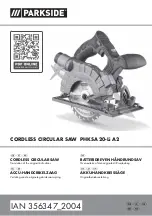
64
Basic Saw Operations (continued)
The dado head is assembled to the saw
arbor in the same manner as the saw
blade. The arbor on the saw, is long
enough so that the widest cut that can be
made is 13/16" wide. It is not necessary to
install the outside loose collar before
screwing on the arbor nut. Make sure the
arbor nut is tight.
When cutting a “deep” dado or a wide
groove it is necessary to remove only a
small amount of material (1/8"-1/4") at a
time. Continue to increase dado elevation
until the desired depth is reached.
Rabbeting
Rabbeting is known as cutting out a sec-
tion of the corner of a piece of material,
across an end or along an edge.
To make a rabbet requires cuts which do
not go all the way through the material.
Therefore, the blade guard must be
removed.
1. Remove blade guard.
2. For rabbeting along an edge (long way
of workpiece) as shown add facing to
rip fence approximately as high as the
workpiece is wide. Adjust rip fence and
blade to required dimensions; then
make first cut with board flat on table as
any rip (type) cut; make second cut with
workpiece on edge. Follow all precau-
tions, safety instructions, and opera-
tional instructions as for ripping, or rip
type operations, including feather-
boards and push stick, etc.
3. For rabbeting across an end, for work-
piece 10-1/2” and narrower, make the
rabbet cut with the board flat on the
table. Using the miter gauge fitted with
a facing, follow the same procedures
and instructions for cross cutting mak-
ing successive cuts across the width of
the workpiece to obtain the desired
width of cut. Do not use the rip fence for
rabbeting across the end.
Some rabbet cuts can also be made in
one pass of the workpiece over the cutter
using a dado head.
WARNING: For your own safety,
install blade guard immediately
upon completion of rabbeting
operation.
Ploughing and Molding
Ploughing is grooving with the grain the
long way of the workpiece, using the
fence. Use featherboards and push sticks
as required.
Molding is shaping the workpiece with the
grain the long way of the workpiece, using
the fence. Use featherboards and push
sticks as required.
Rabbet
Second Cut
First Cut
This side against fence
when making second cut
Rabbet
Second Cut Etc.
First
Cut
Ploughing
















































